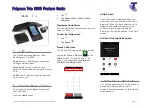
1-6
Installation and Upgrade Guide for Cisco Unified MeetingPlace Web Conferencing Release 6.x
OL-13418-01
Chapter 1 Introducing Cisco Unified MeetingPlace Web Conferencing
About Cisco Unified MeetingPlace Web Conferencing
Figure 1-2
Cisco Unified MeetingPlace Web Conferencing Components
1.
Users submit requests to schedule meetings, change their profile, and join meetings.
2.
ISAPI processes user requests for the Cisco MeetingPlace Agent Service and generates HTML
pages to display to users for meeting scheduling, meeting details, and account update pages.
3.
When users join a meeting, their meeting consoles connect to the Flash Media Server on the Cisco
Unified MeetingPlace Web Conferencing server.
4.
The Agent Service manages all user requests from ISAPI and accomplishes the following:
–
Passes the scheduling requests and profile updates to the Cisco Unified MeetingPlace Audio
Server system.
–
Coordinates between the meeting room components (Connect Gateway, Connect Application
Service, Flash Media Administration Server, and Flash Media Server) and the rest of the Cisco
Unified MeetingPlace system.
–
Acts as a communication channel between the Audio Server system and the Video Service. For
information about the Video Service, refer to the
Administration Guide for Cisco Unified
MeetingPlace
Video Integration
.)
–
Retrieves and stores information in the MPWEB database.
Internet browser
Cisco Unified
MeetingPlace
Audio Server
System
SQL
Server
1
2
3
4
5
6
Gateway SIM
Gateway SIM
191839
Audio
Service
Video
Service
(optional)
Multipoint
Control
Unit
Video
endpoint
Agent
Service
Web
Conferencing
Home Page
ISAPI
HTTP
Flash
meeting
console
Flash
Media
Server
Replication
Service
















































